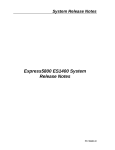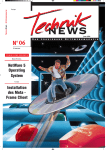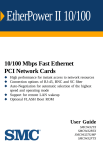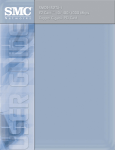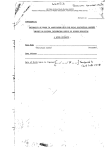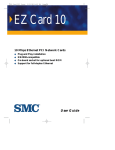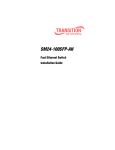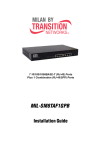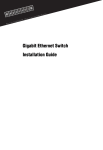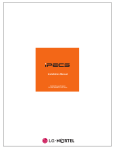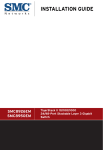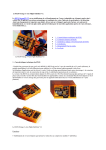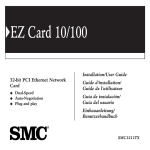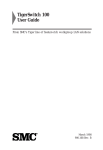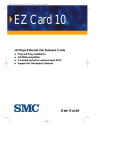Download SMC Networks TigerCard 1000 User's Manual
Transcript
TigerCard 1000 1000 Mbps Gigabit Ethernet PCI Network Card u u u u u u High performance for instant access to network resources Conforms to IEEE 802.3z 1000BASE-SX Supports PCI 32- and 64-bit bus-master architectures Full-duplex operation for up to 2 Gbps of bandwidth Support for VLAN tagging with eight levels of priority IP, TCP and UDP checksum off-loading capability reduces CPU overhead User Guide SMC9462SX TigerCard 1000 User Guide From SMC’s Tiger line of feature-rich workgroup LAN solutions 6 Hughes Irvine, CA 92618 Phone: (949) 707-2400 August 1999 Pub. # 150017-102 R02 Information furnished by SMC Networks, Inc. (SMC) is believed to be accurate and reliable. However, no responsibility is assumed by SMC for its use, nor for any infringements of patents or other rights of third parties which may result from its use. No license is granted by implication or otherwise under any patent or patent rights of SMC. SMC reserves the right to change specifications at any time without notice. Copyright © 1999 by SMC Networks, Inc. 6 Hughes, Irvine, California All rights reserved. Printed in Taiwan Trademarks: SMC is a registered trademark; and EtherPower and SuperDisk are trademarks of SMC Networks, Inc. Other product and company names are trademarks or registered trademarks of their respective holders. Limited Warranty HARDWARE: SMC Networks, Inc. (“SMC”) warrants its TigerCard 1000 Network Cards to be free from defects in workmanship and materials, under normal use and service, for the following lengths of time from the date of purchase from SMC or its Authorized Reseller: TigerCard 1000 Network Cards ................................................ Limited Lifetime Driver Software ......................................................................................... 90 days If a product does not operate as warranted during the applicable warranty period, SMC shall, at its option and expense, repair the defective product or part, deliver to Customer an equivalent product or part to replace the defective item, or refund the purchase price paid for the defective product. All products that are replaced will become the property of SMC. Replacement products may be new or reconditioned. Any replaced or repaired product or part has a ninety (90) day warranty or the remainder of the initial warranty period, whichever is longer. SMC shall not be responsible for any custom software or firmware, configuration information, or memory data of Customer contained in, stored on, or integrated with any products returned to SMC pursuant to any warranty. LIMITED LIFETIME: TigerCard 1000 Network Cards have a standard threeyear warranty. If you wish to extend your three-year warranty on these cards to a lifetime warranty, please complete and return the enclosed product registration card within 90 days of purchase from SMC or its Authorized Reseller. Failure to complete and return this card does not affect the standard three-year warranty. After registration, any defective EtherPower 10/100 Network Cards will be repaired or replaced at SMC’s option. SOFTWARE: SMC warrants that the software programs licensed from it will perform in substantial conformance to the program specifications for a period of ninety (90) days from the date of purchase from SMC or its Authorized Reseller. SMC warrants the magnetic media containing software against failure during the warranty period. No updates are provided. SMC’s sole obligation hereunder shall be (at SMC’s discretion) to refund the purchase price paid by Customer for any defective software products or to replace any defective media with software which substantially conform to SMC’s applicable published specifications. Customer assumes responsibility for the selection of the appropriate applications program and associated reference materials. SMC makes no warranty that its software products will work in combination with any hardware or applications software products provided by third parties, that the operation of the software products will be uninterrupted or error free, or that all defects in the software products will be corrected. For any third party products listed in the SMC software product documentation or specifications as being compatible, SMC will make reasonable efforts to provide compatibility, except where the noncompatibility is caused by “bug” or defect in the third party’s product. STANDARD WARRANTY SERVICE: Standard warranty service for hardware products may be obtained by delivering the defective product, accompanied LIMITED WARRANTY by a copy of the dated proof of purchase, to SMC’s Service Center or to an Authorized SMC Service Center during the applicable warranty period. Standard warranty service for software products may be obtained by telephoning SMC’s Service Center or an Authorized SMC Service Center. Products returned to SMC’s Service Center must be pre-authorized by SMC with a Return Material Authorization (RMA) number marked on the outside of the package, and sent prepaid, insured, and packaged appropriately for safe shipment. The repaired or replaced item will be shipped to Customer, at SMC’s expense, not later than thirty (30) days after receipt by SMC. WARRANTIES EXCLUSIVE: IF AN SMC PRODUCT DOES NOT OPERATE AS WARRANTED ABOVE, CUSTOMER’S SOLE REMEDY SHALL BE REPAIR, REPLACEMENT, OR REFUND OF THE PURCHASE PRICE PAID, AT SMC’S OPTION. THE FOREGOING WARRANTIES AND REMEDIES ARE EXCLUSIVE AND ARE IN LIEU OF ALL OTHER WARRANTIES, EXPRESSED OR IMPLIED, EITHER IN FACT OR BY OPERATION OF LAW, STATUTORY OR OTHERWISE, INCLUDING WARRANTIES OF MERCHANTABILITY AND FITNESS FOR A PARTICULAR PURPOSE. SMC NEITHER ASSUMES NOR AUTHORIZES ANY OTHER PERSON TO ASSUME FOR IT ANY OTHER LIABILITY IN CONNECTION WITH THE SALE, INSTALLATION, MAINTENANCE OR USE OF ITS PRODUCTS. SMC SHALL NOT BE LIABLE UNDER THIS WARRANTY IF ITS TESTING AND EXAMINATION DISCLOSE THAT THE ALLEGED DEFECT IN THE PRODUCT DOES NOT EXIST OR WAS CAUSED BY CUSTOMER’S OR ANY THIRD PERSON’S MISUSE, NEGLECT, IMPROPER INSTALLATION OR TESTING, UNAUTHORIZED ATTEMPTS TO REPAIR, OR ANY OTHER CAUSE BEYOND THE RANGE OF INTENDED USE, OR BY ACCIDENT, FIRE, LIGHTNING, OR OTHER HAZARD. LIMITATION OF LIABILITY: IN NO EVENT, WHETHER BASED IN CONTRACT OR TORT (INCLUDING NEGLIGENCE) SHALL SMC BE LIABLE FOR INCIDENTAL, CONSEQUENTIAL, INDIRECT, SPECIAL OR PUNITIVE DAMAGES OF ANY KIND, OR FOR LOSS OF REVENUE, LOSS OF BUSINESS, OR OTHER FINANCIAL LOSS ARISING OUT OF OR IN CONNECTION WITH THE SALE, INSTALLATION, MAINTENANCE, USE, PERFORMANCE, FAILURE, OR INTERRUPTION OF ITS PRODUCTS, EVEN IF SMC OR ITS AUTHORIZED RESELLER HAS BEEN ADVISED OF THE POSSIBILITY OF SUCH DAMAGES. NOTHING HEREIN SHALL HAVE THE EFFECT OF LIMITING OR EXCLUDING SMC’S LIABILITY FOR DEATH OR PERSONAL INJURY CAUSED BY NEGLIGENCE. Some states do not allow the exclusion of implied warranties or the limitation of incidental or consequential damages for consumer products, so the above limitations and exclusions may not apply to you. This warranty gives you specific legal rights which may vary from state to state. SMC Networks, Inc. 6 Hughes Irvine, CA 92618 TABLE 1 OF CONTENTS Installing the Network Card ............................. 1-1 Introduction ................................................................................. 1-1 Hardware Description .............................................................. 1-2 LED Indicators .......................................................................... 1-3 Package Contents ........................................................................ 1-4 SuperDisk Contents ..................................................................... 1-4 System Requirements .................................................................. 1-5 Inserting the Network Card ......................................................... 1-6 PCI Configuration ......................................................................... 1-8 Connection Guidelines ................................................................ 1-8 Connecting a Fiber Cable ............................................................ 1-9 2 Installing Network Drivers ............................... 2-1 Windows NT 4.0 Installation ........................................................ 2-1 First-Time Installation ............................................................... 2-1 Secondary installation ............................................................... 2-3 Further Configuration ............................................................... 2-4 Novell NetWare Installation ......................................................... 2-5 NetWare Server 5.0 .................................................................. 2-5 NetWare Server 4.11 ................................................................ 2-6 NetWare Server 3.12 and 3.2 ................................................... 2-8 Linux 2.0.35 or Later Installation ................................................ 2-10 Manual Loading and Configuration ......................................... 2-10 Automatic Installation ............................................................. 2-11 Windows 98 Installation ............................................................. 2-13 Other Installations ...................................................................... 2-15 Latest Drivers ............................................................................. 2-15 i TABLE OF CONTENTS 3 Configuring and Testing the Network Card ......................................... 3-1 Introduction ................................................................................. 3-1 How to Run the Windows NT Utility ....................................... 3-2 Network Card Information ........................................................... 3-3 Locally Administered Network Address .................................... 3-3 Advanced Properties .................................................................... 3-4 Link Parameters ........................................................................ 3-4 Packet Propulsion ..................................................................... 3-5 Jumbo Frame Support .............................................................. 3-5 VLAN Properties .......................................................................... 3-6 Using VLANs ............................................................................. 3-6 Traffic Priority ........................................................................... 3-7 VLAN Table Maintenance ......................................................... 3-8 VLAN Capabilities ..................................................................... 3-8 Network Card Diagnostics ........................................................... 3-9 Local Tests ................................................................................ 3-9 Send and Receive Test .......................................................... 3-10 A Troubleshooting ............................................... A-1 PCI Compatibility ........................................................................ A-1 Solutions for Common Problems ................................................ A-3 Network Card Installation Problems ........................................ A-3 Network Connection Problems ............................................... A-4 B Cables ................................................................. B-1 Cable Specifications .................................................................... B-1 C Specifications ..................................................... C-1 General Specifications ................................................................ C-1 Index ii COMPLIANCES FCC - Class B This equipment has been tested and found to comply with the limits for a Class B digital device, pursuant to Part 15 of the FCC Rules. These limits are designed to provide reasonable protection against harmful interference in a residential installation. This equipment generates, uses and can radiate radio frequency energy and, if not installed and used in accordance with instructions, may cause harmful interference to radio communications. However, there is no guarantee that the interference will not occur in a particular installation. If this equipment does cause harmful interference to radio or television reception, which can be determined by turning the equipment off and on, the user is encouraged to try to correct the interference by one or more of the following measures: • Reorient the receiving antenna • Increase the separation between the equipment and receiver • Connect the equipment into an outlet on a circuit different from that to which the receiver is connected • Consult the dealer or an experienced radio/TV technician for help Industry Canada - Class B This digital apparatus does not exceed the Class B limits for radio noise emissions from digital apparatus as set out in the interference-causing equipment standard entitled “Digital Apparatus”, ICES-003 of Industry Canada. Cet appareil numérique respecte les limites de bruits radioélectriques applicables aux appareils numériques de Classe B prescrites dans la norme sur le matérial brouilleur: “Appareils Numériques”, NMB-003 édictée par l’Industrie. EN55022 (CISPR-22) - Class B This unit was tested and found to comply with the Class B limits of EN55022 (CISPR 22) and the immunity requirements of EN50082-1. EC Conformance Declaration This information technology product was found to comply with the requirements of the Low Voltage Directive 73/23/EEC and the EMC Directive 89/336/EEC and carries the CE Mark accordingly. An EC Declaration of Conformity was issued for this product by: SMC (Europe) Limited 1st Floor, Pyramid House, Easthampstead Road, Bracknell, Berkshire RG12 1NS, United Kingdom iii COMPLIANCES Japan VCCI Class B Class I Laser Safety Compliance Warning: Fiber Optic Port Safety Never look at the transmit laser while it is powered on. Also, never look directly at the fiber TX port and fiber cable ends when they are powered on. Avertissment: Ports pour fibres optiques - sécurité sur le plan optique Ne regardez jamais le laser tant qu'il est sous tension. Ne regardez jamais directement le port TX (Transmission) à fibres optiques et les embouts de câbles à fibres optiques tant qu'ils sont sous tension. Warnhinweis: Faseroptikanschlüsse - Optische Sicherheit Niemals ein Übertragungslaser betrachten, während dieses eingeschaltet ist. Niemals direkt auf den Faser-TX-Anschluß und auf die Faserkabelenden schauen, während diese eingeschaltet sind. iv CHAPTER 1 INSTALLING THE NETWORK CARD Introduction SMC’s TigerCard 1000 network interface card is a Gigabit Ethernet card for PCI local bus compliant computers. Operating under the 1000BASE-SX short-wavelength laser specification, this adapter provides up to ten times the bandwidth of Fast Ethernet over multimode fiber links. A true plug-and-play device, this card is auto-configurable upon power up and supports advanced features such as VLAN tagging, QoS priority queuing, and full-duplex flow control. Leading-edge ASIC technology and performanceenhancing techniques maximize throughput and minimize CPU utilization. The result is a network card that delivers the performance and reliability demanded by today’s high-end servers and workstations. 1-1 INSTALLING THE NETWORK CARD Hardware Description The TigerCard 1000 is a Gigabit Ethernet network card designed for 32-bit and 64-bit PCI-bus computers. The SC fiber connector enables the network card to support 1000 Mbps transmissions at half and full duplex over 62.5/125 and 50/125 micron multimode fiber cable. Figure 1-1. The TigerCard 1000 1-2 INSTALLING THE NETWORK CARD LED Indicators The TigerCard 1000 network card includes three status LED indicators. The “LNK,” “FDX” and “ACT” LEDs are grouped together below the SC fiber port on the card’s bracket. All the LED indicators are as described in the following figure and table. Figure 1-2. Status LEDs LED Condition LNK Green FDX Off Green Off ACT Flashing Green Status Indicates a valid 1000BASE-SX connection on the fiber port. Power is off or connection is invalid. Indicates the network card is operating in full-duplex mode. Indicates the network card is operating in half-duplex mode. Indicates that the network card is transmitting or receiving data. 1-3 INSTALLING THE NETWORK CARD Package Contents After unpacking the TigerCard 1000, check the contents of the box to be sure you’ve received the following components: u u u u TigerCard 1000 network card SMC9462SX SuperDisk™ network drivers diskette This User Guide SMC Warranty Registration Card Immediately inform your dealer in the event of any incorrect, missing or damaged parts. If possible, please retain the carton and original packing materials in case there is a need to return the product. Please fill out and return the Warranty Registration Card to SMC or register on SMC’s Web site. The TigerCard 1000 is covered by a limited lifetime warranty. SuperDisk Contents The SuperDisk contains drivers and other files to make network card configuration, testing, and driver installation easy. u u u u 1-4 RELEASE.HTM—a summary of the contents of the driver diskette in HTML format for viewing using a Web browser. README.TXT—contains basic information and instructions for installing and using the network card. SMCcfg.EXE—the properties page DLL file that includes configuration and diagnostic utilities under Windows NT 4.0. Driver-installation “TXT” files—contain installation instructions for a particular driver. INSTALLING THE NETWORK CARD System Requirements Before you install the TigerCard 1000 card, check your system for the following requirements: u u u u A PC and BIOS that support the PCI Local Bus Specification v2.0 or later An available bus-mastering 32-bit or 64-bit PCI slot 62.5/125 or 50/125 micron multimode fiber cable (refer to the tables in Appendix B) An IEEE 802.3z-compliant Gigabit Ethernet switch or buffered repeater installed in your network 1-5 INSTALLING THE NETWORK CARD Inserting the Network Card WARNINGS: • Network cards are sensitive to static electricity. To protect the card, avoid touching its electrical components and always touch the metal chassis of your computer before handling the card. • Backup your SuperDisk driver diskette and use the copy as the working diskette to protect the original from accidental damage. 1. Switch off the computer, unplug the power cord, and remove the computer’s cover. 2. Select an available 32-bit or 64-bit bus-mastering PCI slot and remove the cover bracket. • Use a 64-bit PCI slot if your PC supports this standard. • If using a 32-bit PCI slot, the end of the card’s edge connector will be exposed. Be careful that it does not touch any conducting parts on the PC motherboard. Note: Some PC motherboard designs may not provide adequate space behind all 32-bit PCI slots to properly install the network card. 3. Install the network card into the slot so that it is firmly seated. Then, screw the card’s bracket securely into the PC’s chassis. 1-6 INSTALLING THE NETWORK CARD Figure 1-3. Inserting the Network Card 4. Replace the chassis cover on your PC and power it on. 5. The TigerCard 1000 card should be automatically configured by the host computer’s BIOS. However, if you have an older computer, you may have to manually configure the computer’s BIOS settings. 6. The SMC SuperDisk that accompanies the TigerCard 1000 contains all the network operating system drivers supported by this card. Please read the “RELEASE.TXT” file on the diskette for a list of all drivers. Refer to Chapter 2 in this guide for instructions on installing drivers. Also, a text file is included with each driver to detail the proper installation procedure. Any new or updated drivers can be downloaded from SMC’s Web site (see the back cover of this guide). 1-7 INSTALLING THE NETWORK CARD PCI Configuration In most cases, your network card is automatically configured when you power-up your computer. In certain computers, however, you must modify PCI settings by running your computer’s BIOS Setup program. For more information, refer to “PCI Compatibility” on page A-2. Connection Guidelines To connect to a 1000BASE-SX Gigabit Ethernet device, use the SC connector on the network card and 62.5/125 or 50/125 micron multimode fiber optic cable. Note that for 62.5/125 micron cable with ST connectors, SMC provides an optional SC to ST plug converter (SC-ST Converter, P/N 99-012034-091). The attached device must be within the distance limitations specified by the IEEE 802.3z 1000BASE-SX specification. Observe the following guidelines for 1000BASE-SX operation: u u 1-8 The maximum length of a fiber segment is 270 meters for 62.5/125 micron cable and 550 meters for 50/125 micron cable. For additional information on cable lengths, refer to Appendix B. For 1000 Mbps operation, the TigerCard 1000 card must be connected to a 1000BASE-SX compliant switch or buffered repeater. INSTALLING THE NETWORK CARD Connecting a Fiber Cable Use the following procedure to make an SC connection to the network. Note that because SC connectors are keyed, they can only be attached in one orientation. Caution: This network card uses lasers to transmit signals over fiber optic cable. The lasers are compliant with the requirements of a Class 1 Laser Product and are inherently eye safe in normal operation. However, you should never look directly at the transmit port when it is powered on. 1. Remove and keep the SC connector’s rubber cover. When not connected to a fiber cable, the rubber cover should be replaced to protect the optics. 2. Connect one end of the cable to the card’s SC connector (see Figure 2-4) and the other end of the cable to the fiber connector on the network switch or buffered repeater. 3. Make certain that the network device you are connecting to is compliant with IEEE 802.3z 1000BASE-SX. Figure 2-4. Connecting Fiber Cable 1-9 INSTALLING THE NETWORK CARD 1-10 CHAPTER 2 INSTALLING NETWORK DRIVERS This chapter describes how to install and configure network drivers for the TigerCard 1000 network card. The drivers for this TigerCard 1000 network card are not compatible with those on previous SuperDisks. Therefore, use only the drivers on the SuperDisk supplied with this network card. Windows NT 4.0 Installation Caution: Prior to installing the driver, make sure you have upgraded to NT Service Pack 3 or later. Also, if you are installing on an older PC model (Pentium or earlier), upgrade the BIOS to the latest version. First-Time Installation If you’ve already installed a network card, configured Windows NT Networking, or configured a network driver, refer to the procedure titled “Secondary Installation” on page 2-3. 1. If Windows NT is already installed on your computer, proceed to Step 2. Otherwise, complete a first-time Windows NT installation without the SMC network card installed. Be sure to also install NT Service Packet 3 or later. 2. Shut down your PC, install the SMC network card, and attach the network cable. Restart Windows NT. 2-1 INSTALLING NETWORK DRIVERS 3. Double-click on the “My Computer,” “Control Panel,” and “Network” icons. The “Network Configuration” window appears, prompting you to install Windows NT Networking. Select “Yes.” Windows NT invokes the “Network Setup Wizard.” Click on “Next.” 4. When prompted to “Search for a Network Adapter,” click on “Select from List.” 5. When prompted to “Select a Network Adapter,” click on “Have Disk.” Insert the SuperDisk when prompted and click on “OK.” 6. You are presented with the “Select OEM Option” window. Highlight “TigerCard 1000” and click on “OK.” 7. When prompted to “Search for an Adapter,” click on “Next.” 8. Select network protocols when prompted and click “Next.” Note: To complete a TCP/IP installation, you will need to know your IP Address and Subnet Mask. For further information, contact your network administrator or Internet service provider. 9. Click on “Next” and then “Next” again when prompted to “Install Network Components.” When prompted for Windows NT files, type the path to your Windows NT CD-ROM installation files (e.g., D:\WINNT), and click on “OK.” 10. You are presented with the “Network Card Setup” window where you can specify the network card data rate. “AUTONEGOTIATE” is the recommended setting for the TigerCard 1000 network card. Select “Continue” after verifying the network card settings. 11. Click on “Next” and then “Next” again when prompted to “Start the Network.” 2-2 INSTALLING NETWORK DRIVERS 12. Enter the “Workgroup” or “Domain” names (optional) when prompted and click on “Next.” 13. Select “Finish” when prompted, and click on “Yes” when prompted to reboot. Remove the SuperDisk. Secondary Installation Follow this procedure if you have already installed another network card or loaded another driver. 1. Be sure to install Windows NT Service Packet 3 or later if it is not already installed. 2. Install the SMC network card (if not already installed), attach the network cable, and boot Windows NT. 3. Double-click on the “My Computer,” “Control Panel,” and “Network” icons. From the “Network” window, select the Adapter tab. 4. Do not select any of the network cards listed. Select “Add.” 5. You are presented with the “Select Network Adapter” window. Click on “Have Disk.” 6. You are presented with the “Insert Disk” window. Specify the path to the root directory of the SuperDisk (e.g., A:\) and click on “OK.” 7. You are presented with the “Select OEM Option” window. Highlight “TigerCard 1000” and click on “OK.” 8. You are presented with the “Network Card Setup” window where you can specify the network card data rate. “AUTONEGOTIATE” is the recommended setting for the TigerCard 10/100 network card. Select “OK” after verifying the network card settings. 2-3 INSTALLING NETWORK DRIVERS 9. You are presented with the “Network” window where the SMC network card is now listed as an installed adapter. At this point you can select “Close” to exit the Network applet and follow the prompts to restart Windows NT. 10. When prompted, select “Yes” to reboot and initiate the changes. Further Configuration You can modify card settings, install additional protocols and other network components via the Windows NT “Network” applet. 1. Double-click on the “My Computer,” “Control Panel,” and “Network” icons. The “Network” dialog box appears. If the correct network protocols are not installed in the “Protocols” tab list box, click on the “Add” button and follow the on-screen directions to select network protocols. 2. Click on the appropriate tab, “Identification,” “Services” or “Bindings,” to add or modify other network components, as needed. 3. To modify other network card properties, click on the “Adapters” tab and select the TigerCard 1000 in the list box. Then click on the “Properties” button to run the card’s configuration utility. Refer to Chapter 3 for a description of the card’s configuration utility and its options. 2-4 INSTALLING NETWORK DRIVERS Novell NetWare Installation NetWare Server 5.0 Installing the LAN driver is part of the NetWare installation process. Use the following instructions with those in the NetWare installation manual to install the driver. You will need the SMC SuperDisk during this procedure. 1. Shutdown your computer and install the TigerCard 1000 network card in a PCI slot. Connect the card to the network using fiber optic cable. 2. Turn your computer on and boot it to the NetWare 5.0 console prompt. 3. At the NetWare console prompt enter the command “load nwconfig” to start the install utility. The Installation Options dialog box is displayed. 4. Select the Driver Options menu item and press enter. The Driver Options dialog box is displayed. 5. Select the Configure Network Drivers menu item and press enter. The Additional Driver Actions dialog box is displayed. 6. Insert the SMC SuperDisk driver diskette into the “A” drive. 7. Select the “Load an additional driver” menu item option and press Enter. The “Select a driver” dialog box is displayed. Press the “Ins” key to Install an unlisted driver. A dialog box indicating the A drive will be scanned for drivers is displayed. Press Enter to continue. 8. Press Enter to select the SMC9462.LAN from the “Select a driver” to install dialog box. A message asking if you want to copy the driver is displayed. Select “Yes” to continue. The device driver is copied. 2-5 INSTALLING NETWORK DRIVERS 9. A screen with three dialog boxes is displayed. To change the driver configuration, tab to the “SMC9462_1 Parameters” dialog box and modify the driver parameters. Depending on the network that the card is attached to, the Link, Speed, Duplex Mode, and Phy Type parameters might need to be changed from their default values. If you are not sure what values are required for your network, contact your network administrator. 10. Tab to the “SMC9462_1 Protocols” and select the desired protocols. 11. Tab to the “Board SMC9462_1 Actions” dialog box. Select the “Save Parameters and Load Driver” option and press Enter to continue. 12. Perform protocol specific configuration as required. 13. Select “No” when asked if you want to load additional drivers. 14. On the “Additional Driver Actions” dialog box, select “Return to previous menu” and press Enter to continue. 15. On the “Driver Options” dialog box, select “Return to previous menu” and press Enter to continue. 16. On the “Installation Options” dialog box, select “Exit” to return to the NetWare console prompt. NetWare Server 4.11 Installing the LAN driver is part of the NetWare installation process. Use the following instructions with those in the NetWare installation manual to install the driver. You will need the SMC SuperDisk during this procedure. 1. Shutdown your computer and install the TigerCard 1000 network card in a PCI slot. Connect the card to the network using fiber optic cable. 2-6 INSTALLING NETWORK DRIVERS 2. Turn your computer on and boot it to the NetWare 4.11 console prompt. 3. At the NetWare console prompt Enter the command “load install” to start the install utility. The Installation Options dialog box is displayed. 4. Select the “Driver Options” menu item and press enter. The “Driver Options” dialog box is displayed. 5. Select the “Configure Network Drivers” menu item and press Enter. The “Additional Driver Actions” dialog box is displayed. 6. Insert the SMC SuperDisk driver diskette into the “A” drive. 7. Select the “Load an additional driver” menu item option and press Enter. The “Select a driver” dialog box is displayed. Press the “Ins” key to install an unlisted driver. A dialog box is displayed indicating that the A drive will be scanned for drivers. Press Enter to continue. 8. Press Enter to select the SMC9462.LAN from the “Select a driver to install” dialog box. A message asking if you want to copy the driver is displayed. Select “Yes” to continue. The device driver is copied. 9. A screen with three dialog boxes is displayed. To change the driver configuration, tab to the “SMC9462_1 Parameters” dialog box and modify the driver parameters. Depending on the network that the card is attached to, the Link, Speed, Duplex Mode, and Phy Type parameters might need to be changed from their default values. If you are not sure what values are required for your network, contact your network administrator. 10. Tab to the “SMC9462_1 Protocols” and select the desired protocols. 2-7 INSTALLING NETWORK DRIVERS 11. Tab to the “Board SMC9462_1 Actions” dialog box. Select the “Save Parameters and Load Driver” option and press Enter. 12. Perform protocol specific configuration as required. 13. Select “No” when asked if you want to load additional drivers. 14. On the “Additional Driver Actions” dialog box, select “Return to previous menu” and press Enter to continue. 15. On the “Driver Options” dialog box, select “Return to previous menu” and press Enter to continue. 16. On the “Installation Options” dialog box, select “Exit” to return to the NetWare console prompt. NetWare Server 3.12 and 3.2 Installing the LAN driver is part of the NetWare installation process. Use the following instructions with those in the NetWare installation manual to install the driver. You will need the SMC SuperDisk during this procedure. Caution: Prior to installing the SMC9462.LAN ODI driver, you should upgrade to patch kit D (312ptd.exe, see Novell Document No:2936137) or later, or install the NetWare 3.2 Enhancement Pack. Next you need the patch ODI33f.exe or a later program (see Novell document No:2943476) to support Novell’s latest automated services. Finally, you should install the loader patch. The following commands can be used to install the loader patch (assuming NetWare server is in “c:\nwserver” and “312ptd” has been extracted into directory “c:\312ptd”). copy c:\312ptd\native\loader\*.* c:\nwserver cd c:\nwserver lswap loader.exe server.exe 2-8 INSTALLING NETWORK DRIVERS To install the driver: 1. Insert SMC’s SuperDisk driver diskette in your PC’s floppy drive (A:). 2. Change to the NetWare Server directory (for example: CD\NWSERVER). 3. Copy the following files from Driver Diskette to the NetWare Server directory. \NETWARE\ODI\SERVER\SMC9462.LAN 4. Sample AUTOEXEC.NCF for NetWare Server 3.12 AUTOEXEC.NCF LOAD C:SMC9462 slot=3 FRAME=ETHERNET_802.2 NAME=E_8022 BIND IPX to E_8022 NET=10 LOAD C:SMC9462 slot=3 FRAME=ETHERNET_II NAME=E_II BIND IPX to E_II NET=30 LOAD C:SMC9462 slot=3 FRAME=ETHERNET_802.3 NAME=E_8023 BIND IPX to E_8023 NET=20 LOAD C:SMC9462 slot=3 FRAME=ETHERNET_SNAP NAME=E_SNAP BIND IPX to E_SNAP NET=40 5. Reboot the NetWare Server, and the TigerCard 1000 driver will launch automatically for NetWare Server 3.12. 2-9 INSTALLING NETWORK DRIVERS Linux 2.0.35 or Later Installation This section describes the procedure for manual and automatic loading and configuration of the TigerCard 1000 Unix stream driver for Linux 2.0.35 or later. The Linux driver can be found in the “\linux” directory on the SMC SuperDisk driver diskette. Manual Loading and Configuration Note: In the following sections that describe the driver configuration it is suggested that these instructions be carried out in a single-user environment. 1. Log into the Unix system as supervisor (root) and enter Maintenance mode. Make sure that the current directory is “/” using the Unix command “pwd.” 2. Use the following steps to uncompress the package file: # cd /tmp (and insert the floppy in the proper drive, i.e. a:) # mcopy a:/linux/smc9462.o ./smc9462 # cd smc9462 Now the installation directory is ready for use. 3. Load the SMC9462SX device driver module by simply running the command: # insmod smc9462.o You can also specify command line parameters for the driver, such as: insmod smc9462.o mtu=9014 tx_threshold=700 The following command line parameters are supported: mtu: packet size tx_mode: transmission method, 1 pio, 2 busmaster (default) tx_threshold: PDL/PDC threshold, default 700 rx_mode: 1 pio, 2 PDL (default), 4 PDC 2-10 INSTALLING NETWORK DRIVERS speed: connection speed, 0 auto-negotiate (default) duplex: duplex mode, 0 auto-negotiate (default), “half” half duplex, “full” full duplex 3. Assuming the card has been assigned the device name “eth1,” the following command brings the card into an operational state: # ifconfig eth1 up 4. Next the driver must be bound to an active protocol, almost always TCP/IP, using the following command: # ifup eth1 Note that this is meaningful only if the system can find a configuration script that contains the necessary network info. A sample is given below. DEVICE=eth0 USERCTL=no ONBOOT=yes BOOTPROTO=none BROADCAST=207.200.5.255 NETWORK=207.200.5.0 NETMASK=255.255.255.0 IPADDR=207.200.5.2 Automatic Installation This section describes how to install the Linux driver so that it is automatically loaded and configured at boot time. The following description is based on the Red Hat 5.1 distribution, but it can be easily ported to other distributions as well. Note: Before automatically loading the driver at boot time, be sure that the system will function correctly after the driver has been loaded manually. 2-11 INSTALLING NETWORK DRIVERS 1. Log into the Unix system as supervisor (root) and enter Maintenance mode. Make sure that the current directory is “/” using Unix command “pwd.” 2. Use the following steps to uncompress the package file: # cd /tmp (and insert the floppy in the proper drive, i.e. a:) # mcopy a:/linux/smc9462.o ./smc9462 # cd smc9462 Now the installation directory is ready for use. 3. Copy the smc9462.o file to the network modules directory, typically /lib/modules/2.0.x/net. # cp ./smc9462.o /lib/modules/2.0-x/net 4. Locate the boot module configuration file, most commonly “conf.modules” in the “/etc” directory. Add the following line: alias ethx smc9462 where “ethx” will be “eth0” if you don’t have any other adapters, “eth1” if you already have one, and so on. The parameters are the ones discussed in the previous paragraph. 5. Find where the network configuration scripts are, normally the “/etc/sysconfig/network-scripts” directory, and create a configuration script (sample discussed above) named “ifcfg-ethx” that contains network information. # cd /etc/sysconfig/network-scripts # vi ifcfg-ethx (make a configuration script file) 6. Reboot the Unix system to initialize the driver function. # reboot 2-12 INSTALLING NETWORK DRIVERS Windows 98 Installation The TigerCard 1000 driver for Windows 98 conforms to the Network Driver Interface Specification (NDIS) 5.0 and can be found in the “\Win98” directory on the SMC SuperDisk driver diskette. Note: For users of Windows 95 and Windows 95 OSR2 there is an NDIS 3.1 driver provided on the SMC SuperDisk in the “\Win95” directory. The installation procedure for Windows 95 is slightly different than that described here. Refer to the “Win95.txt” driver installation document on the SMC SuperDisk for more information. 1. If Windows 98 is already installed on your computer, proceed to Step 2. Otherwise, complete a first-time Windows 98 installation without the SMC network card installed. 2. Shut down your PC, install the SMC network card, and attach network cable. 3. Power on your PC and boot into Windows 98. 4. When Windows 98 prompts with “PCI Ethernet Controller” in the “New Hardware Found” dialog box, click the “Next” button. 5. Select “Search for the best driver for your device (Recommended)” from the “Add New Hardware Wizard” dialog box, then click the “Next” button. 6. Insert the SMC9462SX Driver Diskette in your floppy drive. 7. Select “Specify a location” and type path “A:\Win98” in the “Add New Hardware Wizard” dialog box, then click the “Next” button. 8. Click the “Next” button in the “Add New Hardware Wizard” dialog box. 2-13 INSTALLING NETWORK DRIVERS 9. Windows 98 will prompt with “SMC9462SX TigerCard 1000 Adapter” in the “Add New Hardware Wizard” dialog box. 10. Click the “Next” button in the “Add New Hardware Wizard” dialog box, then Windows 98 will copy the driver (smc9462.sys) from “A:\Win98” to the “C:\WINDOWS\SYSTEM” directory and the “SMCNET5.INF” file from “A:\Win98” to the “C:\WINDOWS\INF” directory. 11. When Windows prompts with “SMC9462SX TigerCard 1000 adapter” in the “Add New Hardware Wizard” dialog box, click the “Finish” button. 12. Remove the SMC SuperDisk driver diskette from your floppy drive. 13. Restart your computer to initialize the network function. Note: “C:\WINDOWS” is the directory where your Windows 98 system is located. 2-14 INSTALLING NETWORK DRIVERS Other Installations Refer to the installation documents on SMC’s SuperDisk for instructions on installing drivers for use with other operating systems. Please note that new releases of SMC drivers and operating systems may result in procedures slightly different than those described in this chapter. Latest Drivers The SMC SuperDisk contains the latest drivers available at shipping time. If more recent versions of these drivers are available, you can download them from SMC’s Web site. Refer to the back cover of this user guide. 2-15 INSTALLING NETWORK DRIVERS 2-16 CHAPTER 3 CONFIGURING AND TESTING THE NETWORK CARD Introduction This chapter describes the configuration and diagnostic utility available when using the TigerCard 1000 network card in a Windows NT 4.0 environment. When you install the TigerCard 1000 Windows NT 4.0 driver, the advanced configuration utility is also installed. This utility runs when you click on the “Properties” button for the card in the “Network” control panel applet. Using this utility you can perform the following procedures: u u u u View the network card’s status and PCI setup information. See page 3-3. Configure the card’s advanced properties, such as link parameters, Packet Propulsion threshold, and Jumbo Frame support. See page 3-4. Configure VLAN tag capabilities and edit the VLAN ID table. See page 3-6. Perform diagnostics to test the card’s basic functions. See page 3-9. 3-1 CONFIGURING AND TESTING THE NETWORK CARD How to Run the Windows NT Utility Follow these steps from the Windows NT 4.0 desktop. 1. Double-click on the “My Computer,” “Control Panel,” and “Network” icons. The “Network” dialog box appears. 2. Click on the “Adapters” tab and select the TigerCard 1000 card in the list box. 3. Click on the “Properties” button to run the utility. 3-2 CONFIGURING AND TESTING THE NETWORK CARD Network Card Information Select the “Properties” tab in the utility window to view the network card status information and to set a locally administered network address. Locally Administered Network Address This field lets you set a local network MAC address to override the “Permanent Network Address.” This feature is useful if the TigerCard 1000 card is being used in a test environment. However, for normal use it is recommended to retain the factoryset “Permanent” MAC address. 3-3 CONFIGURING AND TESTING THE NETWORK CARD Advanced Properties Select the “Advanced Properties” tab in the utility window to view the network card’s configuration options. This window is shown below and the various items are described in the following table. Link Parameters The network card’s link speed, PHY type (physical connection to the network) and duplex mode can all be set from this page. However, if the “AutoNegotiate Link Parameters” box is checked these parameters are automatically determined and the configuration options greyed out. For most Gigabit Ethernet devices it is recommended to use Auto-Negotiation to set the link parameters. (Note that network card’s link speed can only be 1000 Mbps and the PHY type is always G/MII.) 3-4 CONFIGURING AND TESTING THE NETWORK CARD Packet Propulsion The Packet Propulsion configuration option sets the packet-size threshold at which Propulsion technology is used to burst packets across the PCI bus. Propulsion increases the throughput of small packets by coalescing transfers across the PCI bus. This minimizes host CPU interrupts and bus arbitrations. Use the slider control or edit box to set the packet-size threshold level in bytes (from 0 to 1514, or 9014 if Jumbo Frames is selected). Packets of sizes below this threshold use the Propulsion technique, packets above use the normal scatter-gather method. There is a trade off between the Packet Propulsion and scattergather methods. Packet Propulsion uses more bus resources whereas scatter-gather uses more CPU resources. The optimum setting of the threshold level for a particular environment depends on various factors, such as the PC hardware, other devices on the PCI bus, and the applications being run. Considering all the variables involved, it is recommended to experiment with the Packet Propulsion threshold to find the setting that maximizes the performance of the TigerCard 1000 in your system. Jumbo Frame Support The TigerCard 1000 network card can be configured to use Jumbo Frames. This increases the maximum Ethernet frame size from 1514 bytes up to 9014 bytes. Using Jumbo Frames greatly reduces the packet processing overhead for the host CPU and can boost throughput by up to 300% for bulk data transfers. Note that to use Jumbo Frames, both communicating computers must have network cards that support this feature. Also at full duplex, all switches in the network between the two end computers must be able to accept the extended frame size. With half-duplex connections, all devices in the collision domain would need to support Jumbo Frames. LAN partitioning, either physical 3-5 CONFIGURING AND TESTING THE NETWORK CARD or logical using VLAN tags, can be implemented to allow computers to simultaneously support standard and Jumbo frame sizes. VLAN Properties Select the “VLAN Properties” tab in the utility window to configure the card’s VLAN options and to edit the 16-entry VLAN ID table. Using VLANs The TigerCard 1000 network card supports the IEEE 802.1Q VLAN standard and can be configured to participate in a network with other devices that use VLANs. 3-6 CONFIGURING AND TESTING THE NETWORK CARD An IEEE 802.1Q VLAN is a group of ports that can be located anywhere in the network, but communicate as though they belong to the same physical segment. VLANs help to simplify network management by allowing you to move devices to a new VLAN without having to change any connections. VLANs can be easily organized to reflect departmental groups (such as Marketing or R&D) or usage groups (such as e-mail or video conferencing). VLANs provide greater network efficiency by reducing broadcast traffic, but also allow you to make network changes without having to update IP addresses or IP subnets. VLANs inherently provide a high level of network security, since traffic must pass through a router or a Layer 3 switch to reach a different VLAN. Usually VLANs are configured within IEEE 802.1Q VLAN-enabled switches in the network where ports are assigned to specific VLAN IDs. The TigerCard 1000 allows up to 16 VLAN IDs to be configured directly within the card, so a network server can share its resources with up to 16 VLANs through just one switch link. This avoids the expense of having multiple adapters in a server, and significantly reduces the latency between clients and the server. Note: The VLAN IDs configured within the card must match those in the IEEE 802.1Q-compliant switches throughout the network. Also, the card must be attached to a switch port that permits overlapping VLANs. Traffic Priority The TigerCard 1000 network card supports the IEEE 802.1p Quality of Service standard. Each VLAN is assigned a priority level in the VLAN ID table. Defining priority levels in the network card allows it to work with other network devices to deliver higher priority packets first. 3-7 CONFIGURING AND TESTING THE NETWORK CARD Note that the IEEE 802.1p standard must be supported by the other devices in the network. Refer to the documentation of your network devices for configuration options on handling frames with priority tags. VLAN Table Maintenance The TigerCard 1000’s VLAN configuration features a 16-entry VLAN ID table. Just click on the “Insert” button to add an entry to the table. Each entry requires a VLAN ID number in the range of 0 to 4095 and a user priority level of 0 (lowest) to 7 (highest). The “Modify” and “Delete” buttons can be used to edit or remove entries from the table. The first entry at the top of the table is the VLAN ID that is used in outbound VLAN tagged frames from the network card. All entries in the table are used for filtering inbound frames with unlisted VLAN IDs. Note that the switch port the network card is connected to should be assigned to the VLAN groups specified in the table or permit automatic VLAN registration with GVRP. VLAN Capabilities Three check-box options at the bottom of the VLAN Properties page provide control of the VLAN tagging. “Enable VLAN Filtering” must be checked for the card’s VLAN features to operate. If “Strip Inbound VLAN Tags” is checked, all incoming frames are processed as normal frames. When “Insert Outbound VLAN Tags” is checked, the VLAN ID from the top entry in the table will be appended onto every frame sent from the card. Note that when you make a change to the VLAN Capabilities you must reboot the computer for the changes to take effect. 3-8 CONFIGURING AND TESTING THE NETWORK CARD Network Card Diagnostics Select the “Diagnostics” tab in the utility window to test the basic functions of the network card and its ability to communicate over the network with another card. Local Tests These tests can be used to test the basic functions of the network card. Select the “Run Loopback Tests” and “Run Internal Tests” check boxes either together or separately. The tests to be performed will show “Ready” as the status in the test list box. Then click on the “Run Local Tests” button to start the tests. The progress of each test is shown by the “Test Progress” status bar. When the tests are complete, click on the “View Test Results” button to display the test results. 3-9 CONFIGURING AND TESTING THE NETWORK CARD Send and Receive Test This test verifies that the network cable is connected correctly, so that the network card can transmit and receive data. The test requires two computers with the TigerCard 1000 network card installed. One computer generates and sends test messages, the other computer receives the test messages and transmits them back to the sender. Note: You should run the Local Tests before running the Send and Receive Test to ensure that the card’s basic functions are working properly. To run the test, on one computer be sure the configuration utility is running to enable it as the receiver. On the other computer, simply click on the “Run” button to start sending test messages. The progress of the test is shown by the “Server Activity” status bar. You can view the test results by clicking on the “View Test Results” button. 3-10 APPENDIX A TROUBLESHOOTING PCI Compatibility Early PCI BIOS versions do not properly support the PCI specification and may “hang” when a network card driver tries to load. If this occurs, make sure your BIOS correctly supports the PCI Local Bus Specification (v2.0 or later) and upgrade your computer BIOS to the latest version. Some PCI computers are not self-configuring and require you to perform some or all of the following functions by changing motherboard jumpers and/or configuring the BIOS Setup program: u u u Verify that the PCI slot is an enabled busmaster slot and not a slave PCI slot. The TigerCard 1000 card must be installed in a PCI busmaster slot. In some computers the PCI slot must be configured to enable bus mastering. Refer to your PC’s manual and check the PCI BIOS Setup program to be sure the PCI slot is an enabled busmaster slot. In some computers, you may be required to disable Plug ‘n Play (PnP) in the BIOS Setup program if resources are not properly assigned between the network card and other installed cards. Some computers may require you to reserve interrupts and memory addresses for installed ISA cards to prevent PCI cards from using the same settings. Refer to your PC’s manual and check the PCI BIOS Setup program configuration options for ISA cards. A-1 TROUBLESHOOTING u u u Make sure the PCI slot is configured to support INTA. Be sure that INTA for the slot is assigned to a free interrupt (IRQ) number. Check the BIOS Setup program’s PCI parameters for the slot where the TigerCard 1000 network card is installed. Be sure the slot is configured for level-triggered interrupts instead of edge-triggered interrupts. An example of typical PCI parameters follows: PCI Slot #: (slot number where the network card is installed) Master: Enabled Slave: Enabled Latency Timer: 40 Interrupt Type: Level-Triggered Interrupt Number: (choose any number the BIOS Setup supplies that does not conflict with another installed card) (range is 20 to 255) Note that the wording of these parameters varies with different computers, and not all parameters may be configurable. Always consult your computer manual for information on changing motherboard jumper settings and BIOS Setup program parameters for use with PCI network cards. If you set a motherboard jumper and modify the computer’s BIOS Setup, make sure the jumper and BIOS settings match. A-2 TROUBLESHOOTING Solutions for Common Problems Problems are often caused by cabling errors, conflicts with other devices installed in the same computer, or software that has been configured incorrectly. If you encounter a problem with the TigerCard 1000 network card, use the following checklists to identify and correct the problem. Network Card Installation Problems If your computer can’t find the TigerCard 1000 card or the network driver doesn’t install correctly, check the following items before contacting SMC Technical Support. u u u u u u u Make sure the card is securely seated in the PCI slot. Check for any hardware problems, such as physical damage to the card’s edge connector. Try the card in another PCI busmaster slot. If all fails, test with another TigerCard 1000 card that is known to operate correctly. Check for resource conflict in the PCI configuration. See section “PCI Compatibility” in this chapter. Make sure your computer is using the latest BIOS available. If there are other network cards in the computer, they may be causing conflict. Remove all other cards from the computer and test the TigerCard 1000 separately. Check for a defective computer or PCI bus by trying the network card in another computer that is know to operate correctly. Make sure your computer is using the latest BIOS available. A-3 TROUBLESHOOTING Network Connection Problems There may be a network connection problem if the Link LED on the card’s bracket does not light, or if you can’t access any network resources from the computer. Check the following items before contacting SMC Technical Support. u u u u u u u u A-4 Make sure the cable is within the IEEE 802.3z 1000BASE-SX standard for Gigabit Ethernet. Check the rating of the fiber cable and make sure its length is within the requirements specified in Appendix B. Inspect all network cables and connections. Make sure the network cable is securely attached to the card’s connector. Make sure the correct network card driver is installed for your operating system. If necessary, try reinstalling the driver. Make sure the computer and other network devices are receiving power. Make sure the network card is connected to a Gigabit Ethernet switch or buffered repeater port that is configured for AutoNegotiation. If the card’s duplex mode has been configured manually, check that it matches that of the network device port. The port on the network device that the card is attached to may be defective. Try using another port on the device. If you cannot access a Windows or NetWare service on the network, check that you have enabled and configured the service correctly. If you cannot connect to a particular server, be sure that you have access rights and a valid ID and password. If you cannot access the Internet, be sure you have configured your system for TCP/IP. APPENDIX B CABLES Cable Specifications Multimode Fiber (1000BASE-SX) Cable Cable Type Connector 62.5/125 or 50/125 micron core SC * If using the SC-ST Converter, use only 62.5/125 micron fiber cable 1000BASE-SX Fiber Cable Lengths Core Diameter Modal Bandwidth Maximum Length 62.5/125 microns 160 MHz/km 220 m (722 ft) 200 MHz/km 275 m (902 ft) 400 MHz/km 500 m (1641 ft) 500 MHz/km 550 m (1805 ft) 50/125 microns B-1 CABLES B-2 APPENDIX C SPECIFICATIONS General Specifications Network Interface 1000BASE-SX; multimode fiber cable SC connector (62.5/125 or 50/125 micron core) Optical Wavelength: Transmitter; 840 nm to 860 nm Receiver; 770 nm to 860 nm Data Rate 1 Gbps, half and full duplex Bus Interface 32-bit and 64-bit bus master, PCI Interrupt INTA Cabling 62.5/125 microns: maximum 220 m (722 ft) 50/125 microns: maximum 550 m (1804 ft) Configuration 16-entry VLAN table, 8 priority levels Optional Jumbo Frame support Packet Propulsion threshold level LED Indicators Link Full/half duplex Activity C-1 SPECIFICATIONS Size (without bracket) 3.11 x 6.50 in (7.9 x 16.5 cm) Weight 2.8 oz (80g) Operating Voltage +5 VDC @ 900 mA maximum Temperature Operating 32 to 140°F (0 to 60°C) Storage -40 to 185°F (-40 to 85°C) Humidity 5% to 95% (non-condensing) Standards IEEE 802.3z Gigabit Ethernet IEEE 802.3x Full-Duplex flow control IEEE 802.1Q VLANs IEEE 802.1p Quality of Service PCI v2.1 Compliances CE Mark Emissions FCC Class B VCCI Class B Industry Canada Class B EN55022 (CISPR 22) Class B Safety UL 1950 CSA 22.2 No. 950 EN60950 (TÜV) Warranty Limited lifetime C-2 INDEX Auto-Negotiation 2-2, 3-4 contents package 1-4 SuperDisk 1-4 B D BIOS settings 1-8, A-1 diagnostic tests 3-9 driver diskette 1-4 driver files 1-4, 1-7, 2-1, 2-15 drivers installation 2-1 new or updated 1-7 Release.TXT file 1-7 A C cable fiber 1-5, 1-9 Gigabit Ethernet 1-5 guidelines 1-8 maximum length 1-8 requirements 1-8 compliances iii configuration Linux 2-10 NetWare Server 3.12 and 3.2 2-8 NetWare Server 4.11 2-6 NetWare Server 5.0 2-5 PCI 1-8, 3-3 Windows 98 2-13 Windows NT 2-1 Windows NT utility 3-1 configuring Jumbo Frames 3-5 link parameters 3-4 Packet Propulsion threshold 3-5 VLAN ID table 3-6 VLAN tagging 3-8 connections fiber cable 1-9 guidelines 1-8 to Gigabit Ethernet devices 1-8 E EC conformance iii emissions iii F fiber cable 1-2, 1-5, 1-9 G Gigabit Ethernet 1-1 Gigabit Ethernet cabling 1-5 I indicators 1-3 installation Linux 2-10 NetWare Server 3.12 and 3.2 2-8 NetWare Server 4.11 2-6 NetWare Server 5.0 2-5 E-1 INDEX other 2-15 Windows 98 2-13 Windows NT 2-1 installation instructions 1-6 installation problems A-3 internal tests 3-9 J Jumbo Frames 3-5 L laser safety 1-9 latest drivers 2-15 LEDs activity 1-3 full duplex 1-3 link 1-3 status 1-3 levels of priority 3-8 link parameters 3-4 Linux driver installation 2-10 loopback tests 3-9 M O optimizing performance 3-5 P package contents 1-4 Packet Propusion 3-5 PCI BIOS settings 1-8, A-1 configuration 1-8, A-1 settings 3-1 PCI bus specification 1-5, A-1 performance, optimizing 3-5 priority levels 3-8 problems common A-3 network connections A-4 PCI settings A-1 Q Quality of Service levels 3-8 R multimode fiber cable 1-2 read-me files 1-7 regulatory information iii N S NetWare installation 2-5 network card configuration utility 3-1 information 3-3 installing 1-6 network drivers 1-7, 2-1 send and receive tests 3-10 solutions for problems A-3 specifications general C-1 static electricity 1-6 SuperDisk 1-4, 1-7, 2-1 system requirements 1-5 Index-2 INDEX T tags, VLAN 3-8 testing the network card 3-9 troubleshooting basic A-3 hardware problems A-3 network connections A-4 PCI compatibility A-1 two-node test 3-10 U utility, diagnostic 3-1 V VLAN configuration 3-6 W Windows 95 drivers 2-13 Windows 98 installation 2-13 Windows NT installation 2-1, 3-1 Index-3 INDEX Index-4 FOR TECHNICAL SUPPORT, CALL: From U.S.A. and Canada (8:30 AM - 8:00 PM Pacific Time) (800) SMC-4-YOU; (949) 707-2400; (949) 707-2460 (Fax) From Europe (8:00 AM - 5:30 PM UK Greenwich Mean Time) 44 (0) 1344 420068; 44 (0) 1344 418835 (Fax) INTERNET E-mail addresses: [email protected] Driver updates: http://www.smc.com/support.html SMC Forum on CompuServe: At the prompt (!) type: GO SMC World Wide Web: http://www.smc.com/ FTP Site: ftp.smc.com FOR LITERATURE OR ADVERTISING RESPONSE, U.S.A. and Canada: (800) SMC-4-YOU; Spain: 34-93-477-4920; UK: 44 (0) 1344 418819; Southern Europe: 33 (1) 41.18.68.68; Central/Eastern Europe: 49 (0) 89 92861-200; Nordic: 46 (8) 564 33145; Middle East: 971-4818410; South Africa: 27 (0) 11-3936491; PRC: 86-10-6235-4958; Taiwan: 886-2-2747-4780; Asia Pacific: (65) 338 8916; Korea: 82-2-553-0860; Japan: 81-45-224-2332; Australia: 61-2-9416-0437; India: 91-22-8204437; 6 Hughes Irvine, CA 92618 Phone: (949) 707-2400 CALL: Fax (949) 707-2460 Fax 34-93-477-3774 Fax 44 (0) 1344 418826 Fax 33 (1) 41.18.68.69 Fax 49 (0) 89 92861-230 Fax 46 (8) 87 62 62 Fax 971-4817993 Fax 27 (0) 11-3936491 Fax 86-10-6235-4962 Fax 886-2-2747-9220 Fax (65) 337 7391 Fax 82-2-553-7202 Fax 81-45-224-2331 Fax 61-2-9416-0474 Fax 91-22-8204443 Publication Number: 150017-102 E0899-R02




























































